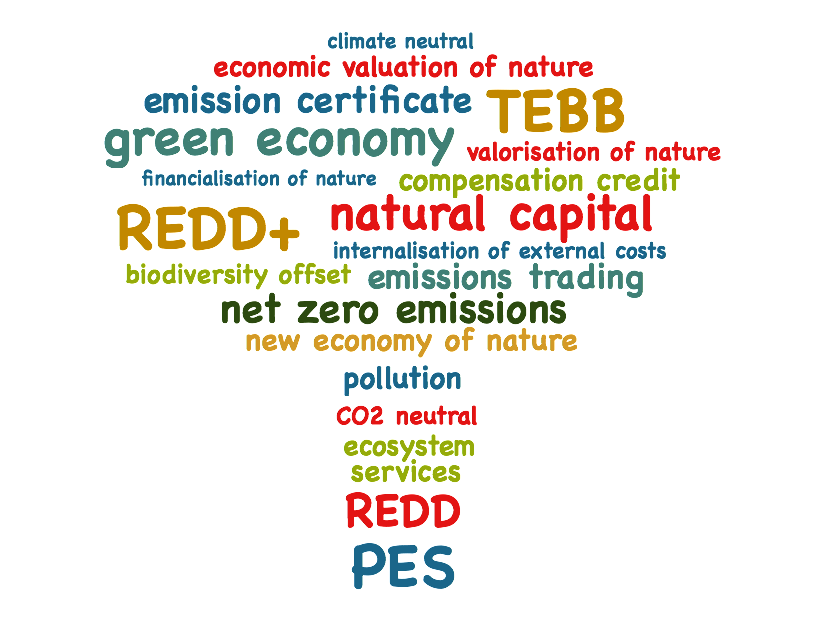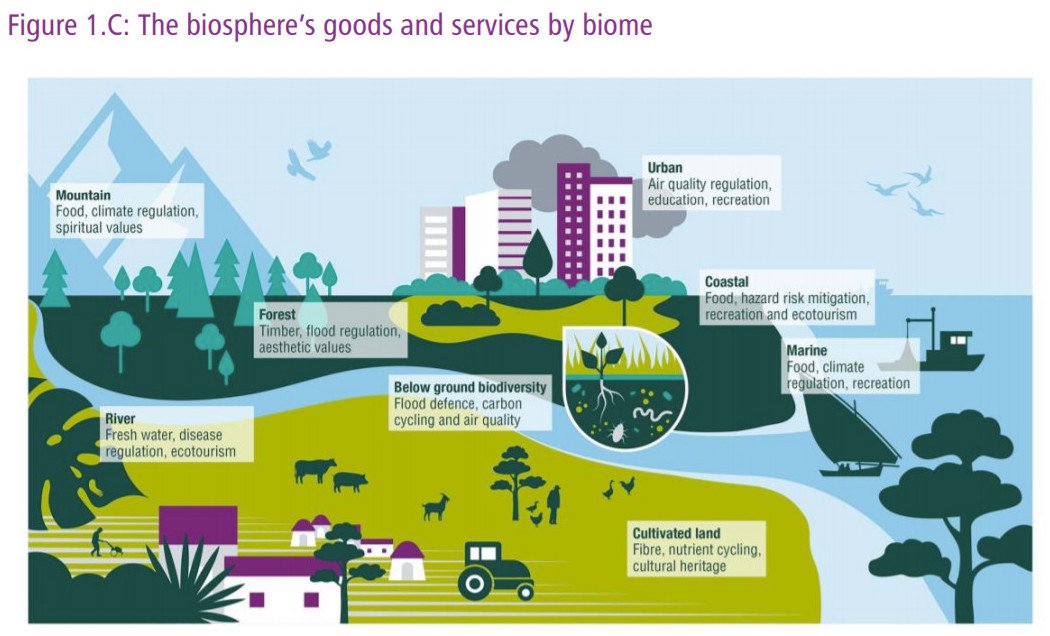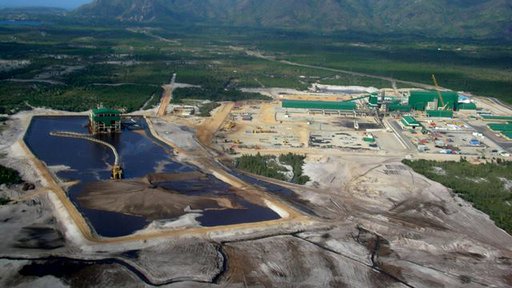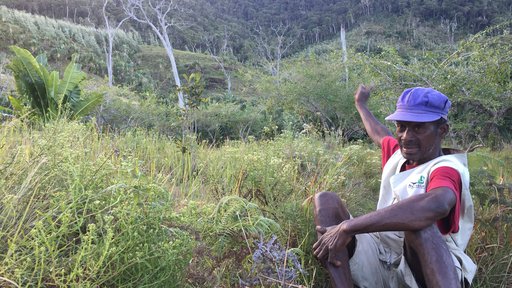
Commodification and financialization of Nature
So-called sustainable investments are on everyone's lips. International institutions such as the IUCN (International Union for Conservation of Nature), banks and corporations, as well as major environmental organizations like WWF, Conservation International or The Nature Conservancy speak of "natural capital", "ecosystem services" and "biodiversity offsets". There is much discussion about methods of measuring the economic value of ecosystems and their importance for the quality of life and as a basis for human economic activity.
But what really happens when people try to measure and assign value to ecosystems or individual plant and animal species? What does "financialization of Nature" actually mean? This term is still relatively little known to the general public, but is playing an increasingly important role in international environmental policy. At first glance, it may seem to make sense - can species and habitats be saved if the nature-destroying industries are charged for the damage they have caused, and have to pay for the long-term damage to people and Nature? The proponents of these concepts, often economists or representatives of industry and banks, argue that the value of Nature has until now received too little attention in economy, and that this also leads to a lack of appreciation.
Critics of these concepts argue that the commodification of Nature leads to the reduction of unique ecosystems to comparable, exchangeable units. If e.g., a forest somewhere is destroyed for palm oil plantations or mining, according to this logic it would be possible to compensate for the destruction by protecting a forest or planting a new one somewhere else - as a so-called compensation project or "offset". The old forest as a home for numerous living creatures, as the livelihood of local people, with all its cultural and spiritual significance, would nevertheless be irreversibly lost.
The effort to measure natural resources economically is not new. Wood, plant and animal products, and land have long been part of the economic cycles and can be bought or sold. Financialization of Nature, however, is about more than just trading of natural products or farmland. By comparing and commodifying living species and habitats, the attempt is being made to convert further parts of Nature into assets and to make them available for trade. This goes beyond tangible products - here, functions and features of living Nature are isolated, economically valued and so made tradable on global markets.

"Ecosystem Services"
Certain functions of an ecosystem, such as the storage of CO2 by trees, the filtering of water by soils, or the pollination of agricultural plants by insects, are called "ecosystem services"
In the debates about biodiversity and climate protection, it is often said that through economic valuation, these ecosystem services can finally get the recognition they deserve. The question is whether this kind of recognition can really solve the multiple biodiversity and climate crises. Here, ecosystems and living beings are seen as economic production units to provide certain services for the benefit of humans, not as life that is precious in its own right.
Business, finance and environmental NGOs
In recent years, numerous interwoven and complex networks have emerged with well-sounding names like "The Capitals Coalition", "Business For Nature", “We Mean Business” or WBCSD (World Business Council for Sustainable Development).
A closer look at the lists of the network members shows that here, destructive and polluting industries are partnering with environmental NGOs and international environmental policy organisations. The question arises here, however, who is influencing whom and with which results? The NGOs need money to be able to work, they get it more and more from industry and finance, e.g. to organize compensation projects. With the ongoing destruction of Nature and the growing consumer awareness for ecological and social problems, banks and corporations need a green image and a justification to continue doing business. The fact that they can adorn themselves with their partnerships for Nature and climate protection provides them the desired image improvement and the license to carry on as before.
Large banks such as HSBC or JP Morgan Chase, often in cooperation with environmental NGOs, sell financial products with a sustainability focus, but at the same time continue to invest in destructive and polluting industries. In addition, there are numerous companies that specialize in assesment reports on natural capital and in trading of biodiversity and climate certificates, as well as consulting on these topics (like Forest Trends and many more). Or finance firms that offer species and ecosystem protection in form of share packages - and turn Nature into an object of speculation, governed by the laws of the free market.
The economic valuation of Nature and so-called "sustainable investments" seem to become a very profitable business. Instead of stricter laws to prevent further destruction and pollution, and a fundamental change of the economic system, more or less voluntary compensations by the companies is seen as the solution, and at the same time new profits are made. How much of this has a truly beneficial effect, and what only looks good on paper, is difficult to identify and prove. However, the destruction itself can in no way be stopped by this.
Highly complex documents, often comprising hundreds of pages, such as the recently published, highly acclaimed "Dasgupta Review" or the the "Natural Capital Protocol", present concepts that can be used to calculate the value of "ecosystem services" or "natural capital". This is supposed to help compensate for the damage and to integrate Nature more into economic decision making. In these concepts, Nature is regarded as an "asset," and so becomes part of the flow of goods, services and wealth in neoliberal capitalism. At the same time, as in the Dasgupta Review, population growth and "the humanity" are blamed for the destruction of nature, instead of focusing on the real causes: global economy based on constant growth and excessive overconsumption of resources by industrialized countries, as well as the extreme global inequality. The focus on "overpopulation" has often been criticized as a very racist idea - the culprits are mostly identified in the Global South and among poor people, and so the focus is diverted away from the enormous energy and resource use of the industrialized world and the decadent lifestyles of rich people in the Global North. These reports and concepts are publicly available, but the many technical terms often make them difficult for lay people to understand, and so there is little public debate about them, while behind the scenes international environmental policy is increasingly dominated by economic thinking.
What is behind all this complexity?
In simple terms, the unique character of habitats and living beings, their very own history and meaning, are reduced to a list of comparable and interchangeable functions. This makes it easier for industries to to get permits to destroy a particular place, for example by mining - because at the same time they offer to restore the functions of that place somewhere else. It is then said that the destruction has been compensated, because the same services can be achieved in another place and thus, at least formally, do not disappear. In reality, it then often results in a double land grab - people who live where the industry destroys Nature, be it for mining, industrial agriculture or timber plantations, are driven off their land. At the same time, a protected area is being established in another place, in which often traditional use by local communities is no longer allowed or is restricted - here, too, people often lose free access to their natural livelihoods. In some cases, fortress conservation is established in those places which means closed off areas strictly guarded by armed rangers. In other cases, the local communities are not completely excluded, but still lose the ability to freely use their land and are forced to work as poorly paid rangers for the protected areas or have to look for another way to make a living, which often does not work.


How "biodiversity offsets" affect people
Websites and glossy brochures published by organizations that advocate concepts like "natural capital" and "ecosystem services", claim that the rights of local and Indigenous communities are respected and supported. A crucial principle in environmental law is the so-called FPIC (Free, Prior and Informed Consent). According to this principle, Indigenous and local communities must be able to decide for themselves what happens to their land. Consultations with local communities according to FPIC must take place at the beginning of and throughout every project, regardless of whether it involves ressource extraction, industry or Nature conservation. This was determined among others by the UN Declaration of the Rights of Indigenous Peoples in 2007, which is a very important declaration, but unfortunately not binding under international law.
Numerous examples show, however, that FPIC is often not respected in compensation projects in the Global South. For example in Madagascar, where a subcontractor of mining giant Rio Tinto has destroyed an endangered coastal forest for mineral extraction and has designated three offset areas in other parts of the region. At first glance, this looks like a gain for biodiversity, since the offsets cover more than three times the area destroyed. However, the offsets are for the most part in already existing protected areas. In the largest of these offset projects, the local population can no longer practice their traditional agriculture and is forced to seek other sources of income. Instead of self-sufficiency in food, which was possible through traditional agriculture, people now have to sell produce to be able to feed their families. Food security is threatened, and the alternative sources of income are not working. Many other cases are documented e.g. in the Environmental Justice Atlas.
The calculations for offsets are often based on fictional future forecasts, where the expected biodiversity losses that would occur on the offset areas without the measures, are in many cases estimated too high. Also offsets are frequently designated within already existing protected areas and then it is said that without the money from the corporations, Nature there would be in a much worse condition - but this cannot be proven exactly.
Since offsets or projects financed by "green investment" predominantly take place in the Global South and/or in areas where Indigenous peoples live, financialization of Nature is a profoundly racist and neo-colonialist idea. The overconsumption in the industrialized countries and the global economic growth are allowed to continue. Destructive industries and the ongoing depletion of Nature are justified, as the companies now claim to provide compensation - but the compensation happens mainly in places whose local populations have lived through a long history of colonialism and exploitation, and keep struggling for land rights and self-determination. To measure Nature only by its "services" and to make it a commodity and an object of speculation, also contradicts many traditional Indigenous worldviews where Nature is seen as living and sacred, and which center a mutual, respectful relationship with the collectively used land.
Of course, there are differences among the many offsetting and “green inverstment” projects in terms of respect for Indigenous land rights and benefits to local communities - but even with flagship projects which are working well, the fundamental injustice remains - people who contribute least to ecological crises are most affected by their impacts, and at the same time have to offset the destruction caused by industrialized countries' overconsumption.
Financialization and commodification only deepen the disconnect between people and Nature, which especially people in industrialized countries urgently need to overcome to get back living within planetary boundaries. But there are other approaches to Nature and climate protection that respect and center human rights, Indigenous land rights and justice, while protecting species and ecosystems, with local communities leading the projects in self-determination.
These forms of relationships with Nature, which are successfully put into practice in many places (or already exist there for many generations), offer hope for real systemic change and a positive coexistence of people and Nature. In later chapters of this campaign, we will report more on these successes and show how we as activists can support conservation justice locally and globally.
" History has seen many attempts to commodify land, food, labor, forests, water, genes, and ideas such as privatization of our traditional knowledge. Financialization of Nature follows in the footsteps of this history and turns the sacredness of our Mother Earth’s carbon cycling and life cycling capacity into property to be bought or sold in a global market. Through this process of creating a new commodity of Nature, Mother Earth’s ability and capacity to support a climate conducive to life and human societies is now passing into the same corporate hands that are destroying the climate and magnifying social inequalities in many ways. It is a violation of the sacred. Plain and simple."
Tom Goldtooth, Indigenous Environmental Network
Sources
We would like to share the materials collected on this page in a spirit of support and solidarity.
As a small group, we unfortunately do not have the capacity to research all the contacts and contact the authors, creators and contributors of the materials listed on this page and to ask them explicitly for their permission, to be linked in this context.
If you are the author, creator, or contributor of any of these materials of any of these materials and do not consent to their use in this context, please let us know at presse(at)extinctionrebellion.de and we will remove it.
VIDEOS
ARTE documentary “Banking Nature”:
WWF: "Our Planet: Too big to fail"
Rights4Nature: Judge Statement Tom Goldtooth, Paris International Rights of Nature Tribunal
Tom Goldtooth, Indigenous Environmental Network (Turtle Island, USA)
ARTICLES
The Guardian, Damian Carrington: Economics of biodiversity review: what are the recommendations?
Landmark report says GDP should be ditched as measure of wealth and nature valued to protect wildlife and humans.
World Rainforest Movement: An (incomplete) List of Concepts that Kill Forests
Heinrich Boell Foundation, Dossier: New Economy of Nature
Heinrich Boell Foundation, Jutta Kill: A new nature in the wake of the Green Economy
Heinrich Boell Foundation, Glossary: Key Terms of the New Economy of Nature
Heinrich Boell Foundation: Further information on the New Economy of Nature
Nature not for sale - Challenging biodiversity offsetting and financialisation of nature/
In-depth reading:
Reports by Friends of the Earth International:
Regulated Destruction: How biodiversity offsetting enables environmental destruction
Nature for Sale: How corporations benefit from the financialization of nature
Can Market-Based Approaches Address Critical Biodiversity Loss?
Robert Fletcher: Review of “The economics of biodiversity: the Dasgupta review”
Jutta Kill: Economic Valuation of nature. The Price to Pay for conservation? A critical Exploration
Reports by World Rainforest Movement:
Examples of proponent's thinking:
The economics of biodiversity: the Dasgupta review
Statement by the CBD (Convention on Biological Diversity) on Natural Capital
NatureVest, „sustainable Investments“ by JP Morgan Chase and The Nature Conservancy
Debate from 2018 on Natural Capital, starting with George Monbiot critique:
The response from the Natural Capital supporterts:
(See Section 4, P. 59, for advice given to companies on biodiversity offsetting)
Member lists of The Capitals Coalition, Business for Nature and WBCSD